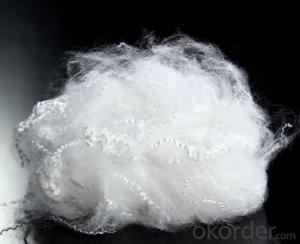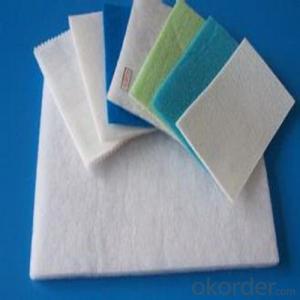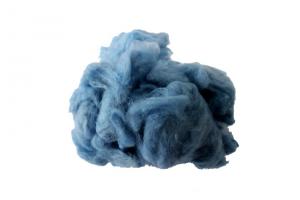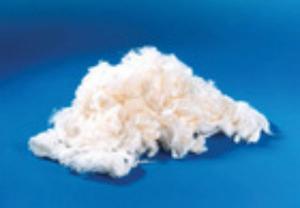15DX32MM HCS Polyester Staple Fiber for Fabric
- Loading Port:
- China main port
- Payment Terms:
- TT OR LC
- Min Order Qty:
- 10 m.t.
- Supply Capability:
- 5000 m.t./month
OKorder Service Pledge
OKorder Financial Service
You Might Also Like
The "15DX32MM HCS Polyester Saple Fiber" is the environment friendly recycling product, which is widely used as the raw materials of bedding and clothing, toy, cushion and nonwoven cloth.
Feature of 15DX32MM HCS Polyester Saple Fiber
1) Siliconized
2) Denier: 15DX32MM HCS
3) Raw white
Usage of 15DX32MM HCS Polyester Saple Fiber
This polyester staple fiber with good hand feeling ,are widely used in bedding ,pillow staffing.
Package of 15DX32MM HCS Polyester Saple Fiber
Packed with PP woven bag, each bale is around 300kg.



We have organized several common questions for our clients,may help you sincerely:
1>How about your company?
A manufacturer & supplier focuses on the production of PP staple fiber which is used as the raw material of textile, automotive interior etc. We have exported this product to Amereica, Europe and South East Asia. Customized product is also available based on your detailed requirements.
2> What's the MOQ ?
We kindly recommend 1x40'HQ as the price would be economical based on large loading quantity.
3>How long can we receive the product after purchase?
It takes about 1 to 2 weeks to finish the production based on the specific production schedual. Then it will depend on the shipping time from loading port to the destination port.
- Q: Is superfine fiber polyester? Are there any differences between the two?
- Polyester fiber: English name Polyester Fiber, commonly known as polyester fiber, is the largest variety of synthetic fiber. Its fabric features smooth, soft luster, sag sense, size stability, easy to wash, quick drying, heat setting, but airtight, muggy.
- Q: What is a review of fiber anti cracking agent?
- 1, double protection, double effect. It contains two kinds of anti swelling components, such as micro expansion agent and synthetic fiber, which can improve the anti cracking ability of concrete from two aspects of physics and chemistry, and provide double protection for concrete.2, special water retention components, improve maintenance efficiency. The unique water retention component can prevent evaporation of water at the early stage of hydration. As the hydration proceeds, the water is released, thereby improving the maintenance efficiency.
- Q: Sliding door pulley which is good?
- Nylon and fiberglass pulley, good toughness, good wear resistance, smooth sliding and durable.
- Q: Polyester fiber, polyester, acrylic, spandex have any harm to the body?
- The main manifestations of skin itching, especially at night.In addition, acrylic fibers are used as underwear materials, and tiny fibers clog up the milk ducts, which are harmful to lactating females.
- Q: What are the elastic fibers and collagen fibers?
- Collagen fibers (collagenous, fiber) collagen fibers are arranged in bundles of loose connective tissue, interwoven with each other, and the fiber bundles are often branched. The fiber has tenacity and good traction resistance. Collagen fibrils were composed of finer fibrils (microfibrils) by electron microscopy. The micro fibril has a special transverse band with a period of 64nm. Each micro fibril has a sequence of light and shade. In comparison with dark band chemical root more free, so more electron microscopic retention stain of collagen fibers: pink, fasciculate, fibrils most of them can not see; collagen fiber mainly containing collagen, amino acid glycine, proline and hydroxyproline. Collagen is the only protein with more hydroxyproline. Therefore, the determination of hydroxyproline can determine the content of collagen in tissues. Collagen accounts for 30% of whole body protein. Protein molecules polymerized into collagen fibrils are called procollagen molecules. Collagen fiber is the most widely distributed and most widely used fiber in three fibers. Widely distributed in various organs. The skin, sclera, and tendon are the most abundant. The staining of collagen fibers is mainly used for the identification of muscle fibers. In children, the proportion of gum fibers in bones is large, and osteoblasts are very active in the manufacture of bone. As a result, children have large bone elasticity and are not easily broken.
- Q: What's the difference between Oxford fabric and polyester fiber?
- Polyester fiber is polyester bag, generally not used Oxford cloth (nylon is nylon) bag made of "strong", the Oxford cloth may be Oxford nylon may also be polyester Oxford, are very strong and solid. And that polyester fiber to do more than 90% of the package, that is, polyester Oxford cloth do,
- Q: Which is better, superfine fiber or PU material?
- PU is Pu, Pu is polyurethane ingredients skin. Now this material is widely used clothing manufacturer known as the production of clothing, leather clothing. PU is the abbreviation of urethane ploy English, Chinese chemical name: polyurethane, its quality is good or bad, good use of imported leather bags;PU matchs leather is general, its reverse side is the leather of second layers of leather, coated with a layer of PU resin on the surface, so also called film leather. The price is lower and the utilization rate is high. It varies with the change of the process also made various grades of varieties, such as imported two layers of leather, with unique technology, stable quality, new varieties and other characteristics, for the present high-grade leather, the price and the class as head of leather.
- Q: The difference between polyvinyl alcohol and polypropylene fiber
- Polypropylene fibers made of polypropylene and a variety of organic and inorganic materials, the composite refining technology of special form, can improve the fracture toughness of concrete, improve the anti cracking performance of concrete, mortar and concrete engineering is cracking, seepage, wear resistance, thermal insulation material of the ideal model.
- Q: How are invisible absorbing materials made? What is the carbon fiber method?
- If the paint is used unilaterally, it may begin with less shells. This point, in erosion resistance, cold pile embedding technology used by predecessors, and so on, the effect is very general. Similarly, when the plane is flying, the air pressure is very frictional, and part of the place is hot. Unilateral use of paint is prone to flaking.
- Q: Bamboo fiber towel why has antibacterial properties, what is bamboo Kun
- Health has always been a topic of concern to most people, a healthy diet, clothing and health, sports health, so that this depends on a person's health, it is commonly used as a towel in life, people will choose to use health, bamboo fiber towels antibacterial; so as to what it can antibacterial bamboo fiber towels? To explain the following: the continuous development of science, research scientists found that bamboo which has a unique material, this material is named bamboo Kun, has natural antibacterial anti mite deodorant pest control function. Under the microscope, the bacteria can breed in cotton and wood fiber products, bamboo fiber products on the bacteria can not survive long time, and in the short term but also disappeared or reduced within 24 hours of bacterial mortality was above 73%. The above results were confirmed by the national cotton textile product quality supervision and inspection center and the Shanghai Institute of microbiology.
Send your message to us
15DX32MM HCS Polyester Staple Fiber for Fabric
- Loading Port:
- China main port
- Payment Terms:
- TT OR LC
- Min Order Qty:
- 10 m.t.
- Supply Capability:
- 5000 m.t./month
OKorder Service Pledge
OKorder Financial Service
Similar products
Hot products
Hot Searches
Related keywords


























